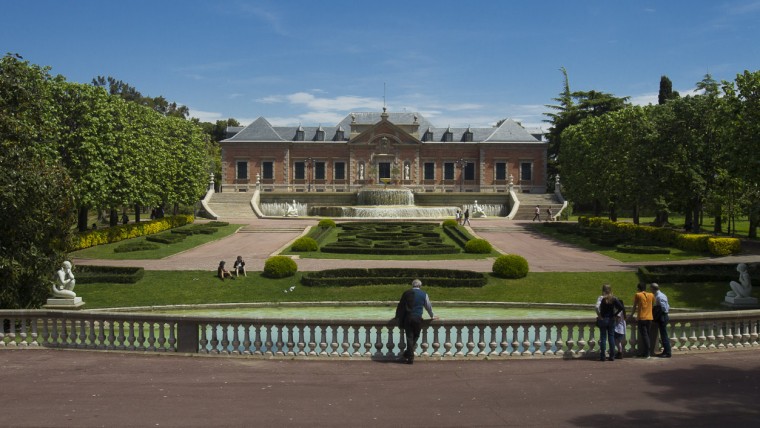
When you enter these gardens you get the impression they were meant for a king. And they were, having been created for Spain’s king at the start of the 20th century. The Jardins de Joan Maragall are extremely elegant, with tree-lined avenues, broad expanses of grass, broderie flowerbeds, ornamental fountains, numerous outdoor sculptures and a small palace that was, and still is, a royal residence.
These tranquil gardens are a world apart, where the only sounds you can hear are the chirping of birds and splash of water flowing from the ornamental fountains. If you go in through the gate on Avinguda de l’Estadi, the first thing you will see are the large grass parterres with extremely tall trees. Gentle, stone-bordered slopes gradually descend to the heart of the gardens: the Palauet Albéniz.

History
These gardens originate from the ones designed by Jean-Claude Nicolas Forestier around the royal pavilion built inside the 1929 International Exposition site on Montjuïc. The building had a twofold purpose: to provide Alfonso XIII with somewhere to hold large receptions and a place to take a break and have a rest during his visits to the Exposition.
Once it was over, the intention was to have it house the city’s music museum, a project that failed to get off the ground though it did establish the name the small palace came to be known by and which the gardens surrounding it were called for many years: Albéniz, in honour of the great musician, Isaac Albéniz.
The gardens were extended in 1970 and named after Joan Maragall. They are one of the three gardens on Montjuïc which were named after Catalan poets during that decade, the others being the Jardins de Mossèn Cinto Verdaguer and Jardins de Mossèn Costa i Llobera, .
Currently the Palauet Albéniz is the official residence for Spain’s royal family when they are on official visits to Barcelona, as well as the city’s illustrious guests, and it is also a centre for important municipal receptions. That explains why the gardens are closed to the public on certain occasions.

Art and Architecture
The old royal pavilion inside the gardens, known as the Palauet Albéniz and built in 1929, is a Neoclassical structure designed by the architect Joan Moya. Built behind the Palau Nacional, it was extended and remodelled in 1970.
Together with the building, the gardens showcase a total of 32 sculptures, some of great quality, by various sculptors in different periods. Prominent among them are Joan Rebull’s Noia ajaguda (Girl Lying Down, 1950); Antoni Casamor’s Nu a l’estany (Nude in the Pool, 1970); Frederic Marès’s Cérvols (Deer, 1967); Louis Sauregeau’s L’aiguadora (The Water Carrier, 1862); Josep Viladomat’s Dos tritons (Two Tritons, 1929); Theophile Eugène’s Susanna al bany (Susanna Bathing); Ernest Maragall’s Al·legoria de la sardana (Sardana Allegory, 1965); two female nudes, one in front of the other, entitled Dona a la cascada (Woman by the Waterfall, 1970), Dona a la cascada (2) (Woman by the Waterfall (2), 1970) and Nu femení (Female Nude, 1965) by Eulàlia Fàbregas de Sentmenat; Pilar Francesch’s Serena (1970); Marifé Tey’s Noia amb casquet de bany (Girl with Bathing Cap, 1970); Enric Monjo’s Dona ajaguda (Reclining Woman, 1970) and Luisa Granero’s Dona amb nena (Woman with Girl) and Dona amb nen (Woman with Boy, 1970).
-
- Phone number
- Palauet Albeniz, de dilluns a divendres de 9 a 13 h: 93 316 10 94
-
- Titularity
- Public center
- Address:
- Av Estadi, 69
- Districte:
- Sants-Montjuïc
- Neighborhood:
- el Poble-sec
- City:
- Barcelona
Timetable
| Dies | Hores |
|---|---|
| Dissabte i diumenge i festius | de 10.00 h a 15.00 h |
Av. de l'Estadi: única porta d'accés oberta, la resta estan tancades.
Els jardins estan tancats quan hi ha actes oficials o visites institucionals al Palauet Albeniz. No es realitzen visites al Palau. Aquestes visites es concedeixen en casos extraordinaris a través de Protocol de l'Ajuntament de Barcelona.

